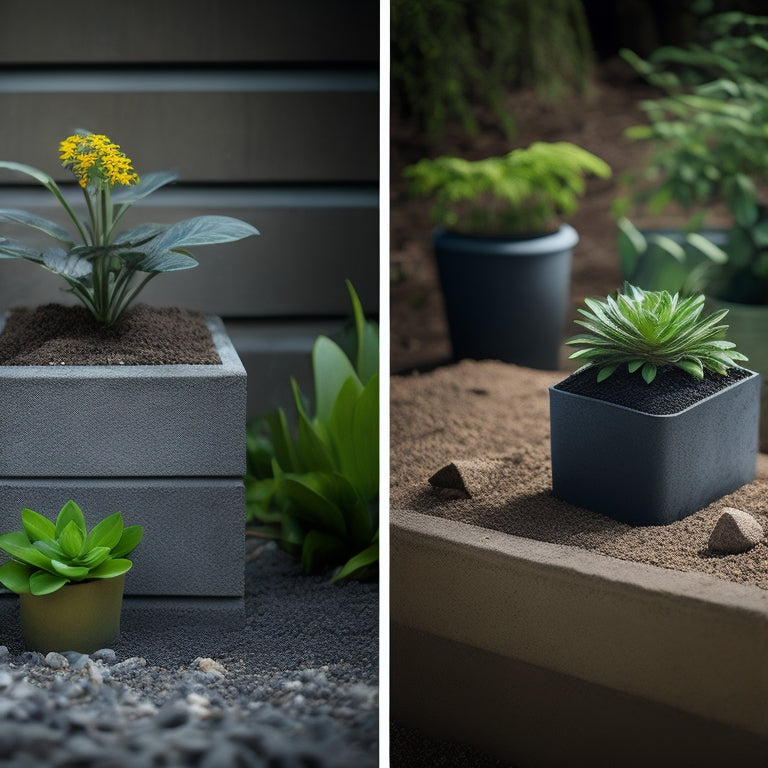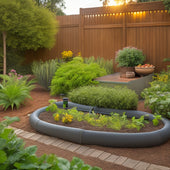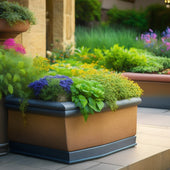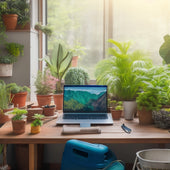
5 Safety Tips for Cinder Block Planters
Share
When building a cinder block planter, you're handling heavy, porous materials that can pose significant safety risks if not managed properly. To guarantee a safe and successful project, always wear protective gear like gloves, safety glasses, and dust masks to prevent injuries. Handle blocks with care by lifting them smoothly and keeping them close to your body, and prevent moisture accumulation issues by incorporating drainage solutions and waterproof coatings. Avoid overloading the planter by calculating its weight capacity and selecting suitable plants, and inspect blocks before assembly to identify any damage or weaknesses. By following these essential safety tips, you'll be well on your way to creating a sturdy and thriving planter.
Key Takeaways
• Always wear protective gear, including gloves, safety glasses, and dust masks, to prevent injury when working with cinder blocks.
• Handle blocks with care by bending at the knees, keeping your back straight, and lifting with your leg muscles to avoid strain.
• Prevent moisture accumulation by incorporating drainage solutions, such as gravel layers and French drain systems, to avoid erosion and structural collapse.
• Avoid overloading the planter by calculating its weight capacity, choosing suitable plants, and using well-draining potting mix to prevent waterlogged soil.
• Inspect blocks before assembly for cracks, chips, or damage that could affect stability, and only use high-quality blocks for a strong and stable planter.
Wear Protective Gear Always
When working with cinder block planters, always wear protective gear, including gloves, safety glasses, and a dust mask, to shield yourself from potential hazards like sharp edges, heavy blocks, and airborne particles.
You're not just protecting yourself from immediate injuries, but also long-term health risks. Eye protection is essential, as cinder block particles can cause eye irritation or even blindness. Safety glasses with shatter-resistant lenses will provide the necessary barrier.
Your hands are also vulnerable to cuts and abrasions, so don durable gloves made from puncture-resistant materials like leather or synthetic fabrics. Look for gloves with reinforced palms and fingertips for added protection.
A dust mask will prevent inhalation of airborne particles, reducing the risk of respiratory problems. By wearing this protective gear, you'll be able to work confidently and efficiently, focusing on your project without worrying about your safety.
Handle Blocks With Care
During the construction of your cinder block planter, you'll be handling blocks of varying weights and sizes. It's important to develop a safe and efficient lifting technique to avoid straining your back or injuring your hands. Proper lifting techniques won't only protect you from injury but also guarantee block stability, which is critical for the structural integrity of your planter.
To handle blocks with care, remember to:
-
Bend at the knees, keeping your back straight, and lift with your leg muscles.
-
Get a firm grip on the block, avoiding loose or crumbling edges.
-
Lift in a smooth, controlled motion, avoiding jerky movements.
-
Keep the block close to your body, maintaining balance and control.
-
Set the block down gently, avoiding sudden drops or impacts.
Prevent Moisture Accumulation Issues
Prevent Moisture Accumulation Issues
As you construct your cinder block planter, make sure to provide adequate drainage to prevent moisture accumulation, which can lead to erosion, crumbling, or even structural collapse. You can achieve this by incorporating effective drainage solutions into your design.
| Drainage Solutions | Moisture Barriers |
|---|---|
| Add a 1-2 inch layer of gravel at the bottom of the planter | Apply a waterproof coating to the cinder blocks |
| Install a French drain system around the planter | Use a waterproof membrane between the soil and cinder blocks |
| Create a slight incline in the planter to facilitate water flow | Seal gaps and joints with a waterproof sealant |
Avoid Overloading the Planter
To guarantee your cinder block planter remains structurally sound, carefully calculate the weight capacity of your planter and avoid overloading it with too much soil, plants, or decorative elements. Overloading can lead to collapse, damage, or even injury. It's crucial to evaluate weight distribution when selecting plants and arranging them in your planter.
Here are some tips to avoid overloading your planter:
-
Choose plants that are suitable for the size and weight capacity of your planter, taking into account their mature size and growth rate.
-
Select plants with similar watering needs to avoid overwatering, which can add excess weight to the planter.
-
Use a well-draining potting mix to prevent waterlogged soil that can increase weight.
-
Avoid using large or heavy decorative elements, such as large stones or sculptures, that can add unnecessary weight.
-
Consider using a planter with built-in support or reinforcement, such as rebar or mesh, to increase its weight capacity.
Inspect Blocks Before Assembly
Before building your cinder block planter, inspect each block for cracks, chips, or other damage that could compromise the structure's stability.
You're looking for any signs of weakness that might affect the block quality and, ultimately, the structural integrity of your planter. Check the blocks for crumbling, erosion, or discoloration, as these can indicate internal damage. Also, inspect the blocks' corners and edges for chips or breaks, which can create weaknesses in the structure.
It's vital to be meticulous during this inspection process, as using damaged blocks can lead to a planter that's prone to collapse or shifting. You don't want to risk your planter toppling over, especially if you're planning to add heavy soil, plants, or decorative features.
Take your time, and sort out any blocks that don't meet your quality standards. Remember, a strong and stable planter starts with selecting high-quality blocks that can support the weight and stress of its contents.
Frequently Asked Questions
Can I Use Old or Damaged Cinder Blocks for My Planter?
When repurposing old or damaged cinder blocks, you're fundamentally recycling materials, which is eco-friendly.
However, you must guarantee the blocks still maintain their structural integrity.
Check for cracks, crumbling, or signs of weathering that could compromise the planter's stability.
If the blocks are still sturdy, you can use them, but if they're severely damaged, it's better to opt for new ones to avoid potential collapse or damage to your plants.
How Often Should I Clean My Cinder Block Planter?
You'll want to clean your cinder block planter regularly to prevent dirt and debris buildup. A good rule of thumb is to clean it every 1-2 weeks, or whenever you notice a thick layer of grime.
For maintenance tips, mix 1 tablespoon of mild dish soap with 1 gallon of warm water, and use a soft-bristled brush to gently scrub away dirt. Rinse thoroughly to prevent soap residue from affecting your plants.
This cleaning frequency will keep your planter looking its best and guarantee healthy plant growth.
Can I Paint or Stain My Cinder Block Planter?
You're ready to add some personality to your cinder block planter! Imagine it transformed, like a canvas waiting for a masterpiece.
Yes, you can paint or stain it! For a pop of color, use exterior acrylic or latex paint. If you prefer a natural look, try staining with a concrete-friendly stain.
Use a roller or brush for even application. Remember to prepare the surface by cleaning and priming, and seal your work with a waterproof coating to guarantee durability.
Are Cinder Block Planters Suitable for Indoor Use?
When you bring your cinder block planter indoors, you're introducing a porous material that can affect air quality. Moisture can seep into the blocks, creating a haven for mold and mildew.
However, with proper care, cinder block planters can thrive in indoor gardening. Guarantee good air circulation, water carefully, and consider sealing the blocks to prevent moisture absorption.
Can I Use Cinder Blocks to Build a Planter With a Trellis?
You're considering building a planter with a trellis using cinder blocks. That's a great idea!
You can create a sturdy structure by stacking the blocks, leaving space for the trellis in between.
Confirm the planter's durability by using a level, applying mortar between the blocks, and anchoring the trellis securely.
With proper construction, your cinder block trellis planter will thrive, providing support for climbing plants while withstanding outdoor elements.
Conclusion
Now that you've learned these essential safety tips for cinder block planters, you're ready to start building.
Remember, a well-constructed planter isn't only aesthetically pleasing but also safe for you and those around it.
Curiously, according to the National Safety Council, falls from ladders and scaffolding account for over 40% of construction-related injuries.
By following these guidelines, you'll minimize the risk of accidents and guarantee a successful DIY project.
Related Posts
-

Irrigation Solutions for Raised Bed Planters Made Easy
You can optimize your raised bed planters' irrigation system by understanding the complex interplay between soil type...
-

Irrigation Solutions for Raised Bed Planters Made Easy
You can optimize your raised bed planters' irrigation system by understanding the complex interplay between soil type...
-

Irrigation Solutions for Raised Bed Planters Made Easy
You can optimize your raised bed planters' irrigation system by understanding the complex interplay between soil type...
-

Irrigation Solutions for Raised Bed Planters Made Easy
You can optimize your raised bed planters' irrigation system by understanding the complex interplay between soil type...
-

Irrigation Solutions for Raised Bed Planters Made Easy
You can optimize your raised bed planters' irrigation system by understanding the complex interplay between soil type...
-

Irrigation Solutions for Raised Bed Planters Made Easy
You can optimize your raised bed planters' irrigation system by understanding the complex interplay between soil type...
-

Irrigation Solutions for Raised Bed Planters Made Easy
You can optimize your raised bed planters' irrigation system by understanding the complex interplay between soil type...
-

Irrigation Solutions for Raised Bed Planters Made Easy
You can optimize your raised bed planters' irrigation system by understanding the complex interplay between soil type...
-

Irrigation Solutions for Raised Bed Planters Made Easy
You can optimize your raised bed planters' irrigation system by understanding the complex interplay between soil type...
-

Irrigation Solutions for Raised Bed Planters Made Easy
You can optimize your raised bed planters' irrigation system by understanding the complex interplay between soil type...
-

Irrigation Solutions for Raised Bed Planters Made Easy
You can optimize your raised bed planters' irrigation system by understanding the complex interplay between soil type...
-

Irrigation Solutions for Raised Bed Planters Made Easy
You can optimize your raised bed planters' irrigation system by understanding the complex interplay between soil type...
-

Irrigation Solutions for Raised Bed Planters Made Easy
You can optimize your raised bed planters' irrigation system by understanding the complex interplay between soil type...
-

Irrigation Solutions for Raised Bed Planters Made Easy
You can optimize your raised bed planters' irrigation system by understanding the complex interplay between soil type...
-

Irrigation Solutions for Raised Bed Planters Made Easy
You can optimize your raised bed planters' irrigation system by understanding the complex interplay between soil type...
-

Irrigation Solutions for Raised Bed Planters Made Easy
You can optimize your raised bed planters' irrigation system by understanding the complex interplay between soil type...
-

Irrigation Solutions for Raised Bed Planters Made Easy
You can optimize your raised bed planters' irrigation system by understanding the complex interplay between soil type...
-

Irrigation Solutions for Raised Bed Planters Made Easy
You can optimize your raised bed planters' irrigation system by understanding the complex interplay between soil type...
-

Irrigation Solutions for Raised Bed Planters Made Easy
You can optimize your raised bed planters' irrigation system by understanding the complex interplay between soil type...
-

Irrigation Solutions for Raised Bed Planters Made Easy
You can optimize your raised bed planters' irrigation system by understanding the complex interplay between soil type...
-

Irrigation Solutions for Raised Bed Planters Made Easy
You can optimize your raised bed planters' irrigation system by understanding the complex interplay between soil type...
-

Irrigation Solutions for Raised Bed Planters Made Easy
You can optimize your raised bed planters' irrigation system by understanding the complex interplay between soil type...
-

Irrigation Solutions for Raised Bed Planters Made Easy
You can optimize your raised bed planters' irrigation system by understanding the complex interplay between soil type...
-

Irrigation Solutions for Raised Bed Planters Made Easy
You can optimize your raised bed planters' irrigation system by understanding the complex interplay between soil type...
-

Irrigation Solutions for Raised Bed Planters Made Easy
You can optimize your raised bed planters' irrigation system by understanding the complex interplay between soil type...
-

Irrigation Solutions for Raised Bed Planters Made Easy
You can optimize your raised bed planters' irrigation system by understanding the complex interplay between soil type...
-

Irrigation Solutions for Raised Bed Planters Made Easy
You can optimize your raised bed planters' irrigation system by understanding the complex interplay between soil type...
-

Irrigation Solutions for Raised Bed Planters Made Easy
You can optimize your raised bed planters' irrigation system by understanding the complex interplay between soil type...
-

5 Essential Drainage Tips for Block Planters
When using block planters, you'll want to guarantee effective drainage to prevent waterlogging and root rot. Start by...
-

5 Essential Drainage Tips for Block Planters
When using block planters, you'll want to guarantee effective drainage to prevent waterlogging and root rot. Start by...
-

5 Essential Drainage Tips for Block Planters
When using block planters, you'll want to guarantee effective drainage to prevent waterlogging and root rot. Start by...
-

5 Essential Drainage Tips for Block Planters
When using block planters, you'll want to guarantee effective drainage to prevent waterlogging and root rot. Start by...
-

5 Essential Drainage Tips for Block Planters
When using block planters, you'll want to guarantee effective drainage to prevent waterlogging and root rot. Start by...
-

5 Essential Drainage Tips for Block Planters
When using block planters, you'll want to guarantee effective drainage to prevent waterlogging and root rot. Start by...
-

5 Essential Drainage Tips for Block Planters
When using block planters, you'll want to guarantee effective drainage to prevent waterlogging and root rot. Start by...
-

5 Essential Drainage Tips for Block Planters
When using block planters, you'll want to guarantee effective drainage to prevent waterlogging and root rot. Start by...
-

5 Essential Drainage Tips for Block Planters
When using block planters, you'll want to guarantee effective drainage to prevent waterlogging and root rot. Start by...
-

5 Essential Drainage Tips for Block Planters
When using block planters, you'll want to guarantee effective drainage to prevent waterlogging and root rot. Start by...
-

5 Essential Drainage Tips for Block Planters
When using block planters, you'll want to guarantee effective drainage to prevent waterlogging and root rot. Start by...
-

5 Essential Drainage Tips for Block Planters
When using block planters, you'll want to guarantee effective drainage to prevent waterlogging and root rot. Start by...
-

5 Essential Drainage Tips for Block Planters
When using block planters, you'll want to guarantee effective drainage to prevent waterlogging and root rot. Start by...
-

5 Essential Drainage Tips for Block Planters
When using block planters, you'll want to guarantee effective drainage to prevent waterlogging and root rot. Start by...
-

5 Essential Drainage Tips for Block Planters
When using block planters, you'll want to guarantee effective drainage to prevent waterlogging and root rot. Start by...
-

5 Essential Drainage Tips for Block Planters
When using block planters, you'll want to guarantee effective drainage to prevent waterlogging and root rot. Start by...
-

5 Essential Drainage Tips for Block Planters
When using block planters, you'll want to guarantee effective drainage to prevent waterlogging and root rot. Start by...
-

5 Essential Drainage Tips for Block Planters
When using block planters, you'll want to guarantee effective drainage to prevent waterlogging and root rot. Start by...
-

Must-Have Tools for Building Block Planters Online
When building block planters online, you'll need essential tools to guarantee a sturdy and visually appealing structu...
-

Must-Have Tools for Building Block Planters Online
When building block planters online, you'll need essential tools to guarantee a sturdy and visually appealing structu...
-

Must-Have Tools for Building Block Planters Online
When building block planters online, you'll need essential tools to guarantee a sturdy and visually appealing structu...
-

Must-Have Tools for Building Block Planters Online
When building block planters online, you'll need essential tools to guarantee a sturdy and visually appealing structu...
-

Must-Have Tools for Building Block Planters Online
When building block planters online, you'll need essential tools to guarantee a sturdy and visually appealing structu...
-

Must-Have Tools for Building Block Planters Online
When building block planters online, you'll need essential tools to guarantee a sturdy and visually appealing structu...
-

Must-Have Tools for Building Block Planters Online
When building block planters online, you'll need essential tools to guarantee a sturdy and visually appealing structu...
-

Must-Have Tools for Building Block Planters Online
When building block planters online, you'll need essential tools to guarantee a sturdy and visually appealing structu...
-

Must-Have Tools for Building Block Planters Online
When building block planters online, you'll need essential tools to guarantee a sturdy and visually appealing structu...
-

Must-Have Tools for Building Block Planters Online
When building block planters online, you'll need essential tools to guarantee a sturdy and visually appealing structu...
-

Must-Have Tools for Building Block Planters Online
When building block planters online, you'll need essential tools to guarantee a sturdy and visually appealing structu...
-

Must-Have Tools for Building Block Planters Online
When building block planters online, you'll need essential tools to guarantee a sturdy and visually appealing structu...
-

Must-Have Tools for Building Block Planters Online
When building block planters online, you'll need essential tools to guarantee a sturdy and visually appealing structu...
-

Must-Have Tools for Building Block Planters Online
When building block planters online, you'll need essential tools to guarantee a sturdy and visually appealing structu...
-

Must-Have Tools for Building Block Planters Online
When building block planters online, you'll need essential tools to guarantee a sturdy and visually appealing structu...
-

Must-Have Tools for Building Block Planters Online
When building block planters online, you'll need essential tools to guarantee a sturdy and visually appealing structu...
-

Must-Have Tools for Building Block Planters Online
When building block planters online, you'll need essential tools to guarantee a sturdy and visually appealing structu...
-

Must-Have Tools for Building Block Planters Online
When building block planters online, you'll need essential tools to guarantee a sturdy and visually appealing structu...
-

Must-Have Tools for Building Block Planters Online
When building block planters online, you'll need essential tools to guarantee a sturdy and visually appealing structu...
-

Must-Have Tools for Building Block Planters Online
When building block planters online, you'll need essential tools to guarantee a sturdy and visually appealing structu...
-

Must-Have Tools for Building Block Planters Online
When building block planters online, you'll need essential tools to guarantee a sturdy and visually appealing structu...
-

Must-Have Tools for Building Block Planters Online
When building block planters online, you'll need essential tools to guarantee a sturdy and visually appealing structu...
-

Must-Have Tools for Building Block Planters Online
When building block planters online, you'll need essential tools to guarantee a sturdy and visually appealing structu...


